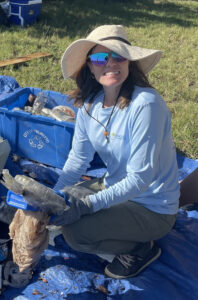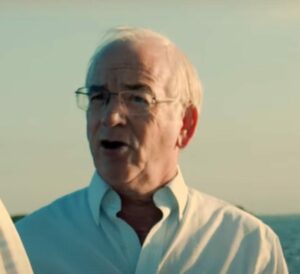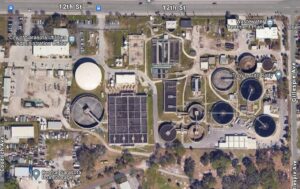Experts say infrastructure needs to catch up with the changing climate.
By Johannes Werner
Original Air Date: August 16, 2024
Host: The City of Sarasota was at the forefront of investment in water treatment in the area. But the rains of Tropical Storm Debby produced one of the biggest spills yet. On Wednesday, Suncoast Waterkeeper, a local watchdog organization, posted on Facebook that the city’s wastewater treatment plant produced a sewage spill approaching 18 million gallons during the storm. A day later, the city confirmed. We have the details.
Dave Tomasko: We were out sampling the bay yesterday, and there’s hardly any oxygen in most of the bay. There’s fish kills. Basically, the only area where there’s oxygen is the very top of the bay. Everything that lives in the bottom of the bay is either dead or is going to die soon because of the lack of oxygen.
Johannes Werner: That’s Dave Tomasko, executive director of the Sarasota Bay Estuary Program. He says the challenge the bay is facing is worse than after Hurricane Ian. Part of what caused it is the big sewage spill at the city’s treatment plant. Sometime during and after the storm — which dumped close to 12 inches of rain on the city within 24 hours — more than six million gallons of raw sewage, plus 11-and-a-half million gallons of partially treated sewage made it into local waterways and the bay.
Only the City of Bradenton’s recent 26-million-gallon spill exceeded that, but Bradenton has been a repeat offender. The Sarasota spill raises eyebrows because the city has been a poster child in the region for early and big investment in its wastewater infrastructure.
In a statement, the city said that it properly reported the spill to state authorities. It also said that “utilities crews did everything humanly possible under the circumstances to mitigate the overflow at the plant, but the volume was too great to contain.” The city’s advanced wastewater treatment plant is rated to handle a little more than 10 million gallons per day. The highest flow it received during Debby was 44.3 million. “Our Utilities Director has worked with small, medium and large wastewater systems during his 42+ year career and has never experienced anything like what occurred with Hurricane Debby.” The city declined to answer any questions.

Abby Tyrna
The fact that the city’s wastewater system was overwhelmed by Debby prompts local environmentalists to put the spotlight on necessary investments. Dr. Abby Tyrna is executive director of Suncoast Waterkeeper. She puts the onus not only on the city, but on homeowners as well. Waterkeeper settled a lawsuit it filed against the City of Bradenton, which has a history of sewage spills, in return for a commitment to invest.
Abby Tyrna: The City of Bradenton, for example, under court order, is required to assess aging pipe and their distribution lines to look for hot spots, places where there are lots of leaks, so that those pipes can be replaced, and that would limit the amount of discharges that the City of Bradenton currently has.
So, what we know is that when they … let’s say they fixed all of the leaky pipes in their distribution center, or in their distribution lines. That would only be 50% of all the distribution pipes, because the other 50% are on private land. So they’re home, your home, my home, that’s those pipes leaving our yard into the main line. Those pipes make up 50% of the distribution of wastewater to the wastewater treatment plant. And so while the municipality could fix 50% of those lines, the other 50% could still be a problem.
JW: Dave Tomasko, with the Sarasota Bay Estuary Program, says the focus should not be just on the wastewater treatment plant, but on the pipes.

Dave Tomasko
DT: One of the best things you can do on the wastewater side is to line those pipes that bring effluent from your house to the lift station, upgrading the lift stations, and also the pipes that go from the lift station to the treatment plant. Because in some areas, those pipes are made out of clay. In some areas, they’re decades old. So from a wastewater side, one of the reasons why we had those releases is so much water came into the plants much more than they were designed to be able to handle. And that’s because of the leaky pipes.
JW: Climate change forces us to update our long-term forecasts, Tomasko says.
DT: This has been described as a 1 in 100 year storm event. We’ve had two of them in two years. This is not abnormal. And the rain data set that we had, that allowed us to figure out the design storms for stormwater. It’s not appropriate anymore. So, for example, in our local area, stormwater treatment systems and stormwater conveyance is based upon the expectation that only 1 in 100 years would we expect 10 inches or more of rainfall in 24 hours. We’ve had that twice in two years.
JW: The Waterkeeper’s Tyrna says this isn’t made any easier by Florida politics.
AT: I think there’s been research on predicting these more intense weather events. I think in a state where we weren’t allowed to say the term climate change for eight years has really put us back. So we weren’t able to look at our infrastructure.
JW: Six years ago, the City of Sarasota passed a $300 million capital improvement plan that includes the wastewater system. But that may need a boost now. Will taxpayers swallow that bitter pill? Tomasko suggests the state’s attitude could be more helpful.

The city’s advanced wastewater treatment plant on 12th St.
DT: What we need to do is we need the state to not fine these local governments. We need the state to help the local governments fix the problem.
JW: For now, be cautious around water. Suncoast Waterkeeper found “enormous amounts of fecal indicators” and issued a no swim advisory for the bay.
Reporting for WSLR in Sarasota, Johannes Werner.
WSLR News aims to keep the local community informed with our 1/2 hour local news show, quarterly newspaper and social media feeds. The local news broadcast airs on Wednesdays and Fridays at 6pm.